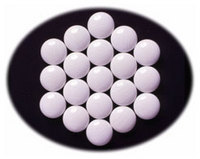

Total:131items
- Pottery & Porcelain (18)
- Lacquerware (4)
- Glasswork (2)
- Wood & Bamboo Work (19)
- Leather Work (1)
- Papermaking (13)
- Textile (20)
- Dyeing products (5)
- Masonry (1)
- Metal Work (11)
- Stationery (4)
- Livingware (3)
- Accessory (4)
- Toys & Entertainment (14)
- Hyuga Goishi: Huga Go Stones
- Kurashiki Hariko: Kurashiki Papier-mache
- Kishu Bina : Kishu Dolls
- Hakata Ningyo: Hakata Doll
- Kaga-mizuhiki: Kaga Paper Cord Ornament
- Kasukabe Oshie Hagoita: Kasukabe's battledore with a padded cloth picture
- Iwatsuki Ningyo: Iwatsuki Doll
- Tsugaru Tako: Tsugaru Kite
- Jindai-Goma: Jindai Spinning Top
- Suruga Hina Dolls
- Knohazaru: Konohazaru Dolls
- Mishima Oni Yōzu kite (Mishima Demon Kite)
- Gunma Kokeshi Doll
- Koga Ningyo: Koga Clay Doll
- Interior (2)
- Other crafts (10)

 |
Main Production Site:Miyazaki |
 《Characteristics》
《Characteristics》Hyuga Go stones are beautifully polished and have a delicate round-shape, that are gentle to touch. They are milky white with an intricately detailed striped pattern. They have a warm glow and shine like jewellery. Hyuga Go stones are characteristically tough and seldom have unsightly marks because of their hard and dense tissue. There are three types of Hyuga Clam Go stones depending on colour and pigment absorbed during their formation beneath the sand. Three of the Clam Go stone types are described below, namely Snow, Moon, and Flower. In total, there are around 50 types differentiated by their thickness.
Snow
They are beautiful creamy-white and have a fine-grained striped pattern that is distinctive of Hyuga Clam Go stones.
Moon
Similar to Snow in appearance with a slightly rougher striped pattern and in contrast to Snow, the colour is slightly cloudy.
Flower
The striped pattern of the Flower variety is somewhat rough and the clamshells have their own unique brownish-red marks.
[Miyazaki prefectural governor-designated traditional handicraft]
Information provided by: Hyuga Clam Go Stones Festival Executive Committee
Translation by: Mariko Maekawa, reviewed by Yoshiko Nagao
| Materials | Clamshells |
|---|---|
| Crafting Processes | Hyuga Clam Go stones are produced through the process outlined below.
(1) Collecting Shells There are various methods to collect shells, including but not limited to the following: digging, underwater digging, digging with the use of an iron pipe, and collecting shells with the use of a sand pump (in chronological order based on the period which they emerged). (2) Gouging Out To gouge the shells to a size of 22mm diameter, a diamond drill is used. This requires a considerable level of skill to gouge out the most suitable parts of the Go stones. Usually only one or two stones can be gouged out from one shell. (3) Thickness Classification The gouged-out shells are classified by 15 levels of thickness. (4) Surface Grinding After the thickness classification, with the use of a grinding machine, the stones are shaped into the shape of Go stones one by one. This process has three stages, ara-zuri (rough grinding), naka-zuri (second grinding), and finishing. During the process, the stones are screened for their quality and then ground further. The grinding and screening process continue for five to six times and gradually condition the stones, achieving the best quality. Only skilled craftsmen with over 10 to 15 years of experience have the ability to create consistently thick stones of high quality. (5) Hand Grinding Without reducing the thickness of the stone surface, the Clam Go stones are conditioned through the use of a shell stick and grinding stone, giving them their unique rounded shape. This is the most important process of all, which requires the highest technique and abundance of experience. The hand grinding process determines the quality of the products, which requires over 15 years of experience. (6) Selection Once classified by thickness, the stones are carefully inspected by colour, shape, glossiness, striped pattern, and scratches. Then the stones will be ranked as Snow, Moon, Flower, and so on, which requires considerable level of experience. (7) Barrel polishing Between 4,000 to 5,000 stones are put into a barrel along with water and polishing paste, then rotated for seven to eight hours. Consequently, the stones rub together in the barrel making the stones shinier. (8) Bleach Soak the stones in hydrogen peroxide water for 2 days and dry them under the sun. Repeat this process 5 to 6 times to make them white. |
| History | Go stones have a long history, originating in China. In the very beginning, Go stones used to be made by stone and wood, and subsequently by jewellery. In the early Meiji era, Go stones began to be manufactured with shells. Manufactured in Osaka, Go stones were created using the Kuwana clamshells from Mikawa (Eastern part of present Aichi Prefecture). Eventually, when the number of clamshells in Kuwana became short, Koshichiro Ishibashi who owned a go stone shop in Osaka heard a rumour from a pharmacy in Toyama that there were many clamshells on Hyuga beach. Immediately, he sent Motojiro Mori there to investigate. When Motojiro arrived in Hyuga, he pleasingly found that the rumour was true as there were plenty of shells. He then shipped the shells collected to Koshichiro in Osaka from Hososhima. This is the beginning of the use the Hyuga clamshells for creating Go stones.
|
| Related URL | http://www.city.hyuga.miyazaki.jp/goishi/ |
◆Event Information
Hyuga Clam Go Stones Festival
takes place on the last Sunday in October every year.
The festival information is available at:
Hyuga City Official Website
(Japanese only)
Assistance needed? For inquiries in English:
JTCO Contact Form
Your inquiries will be forwarded by JTCO in Japanese to the organization you wish to contact.
Please specify the name of the craft/art you wish to inquire about.



